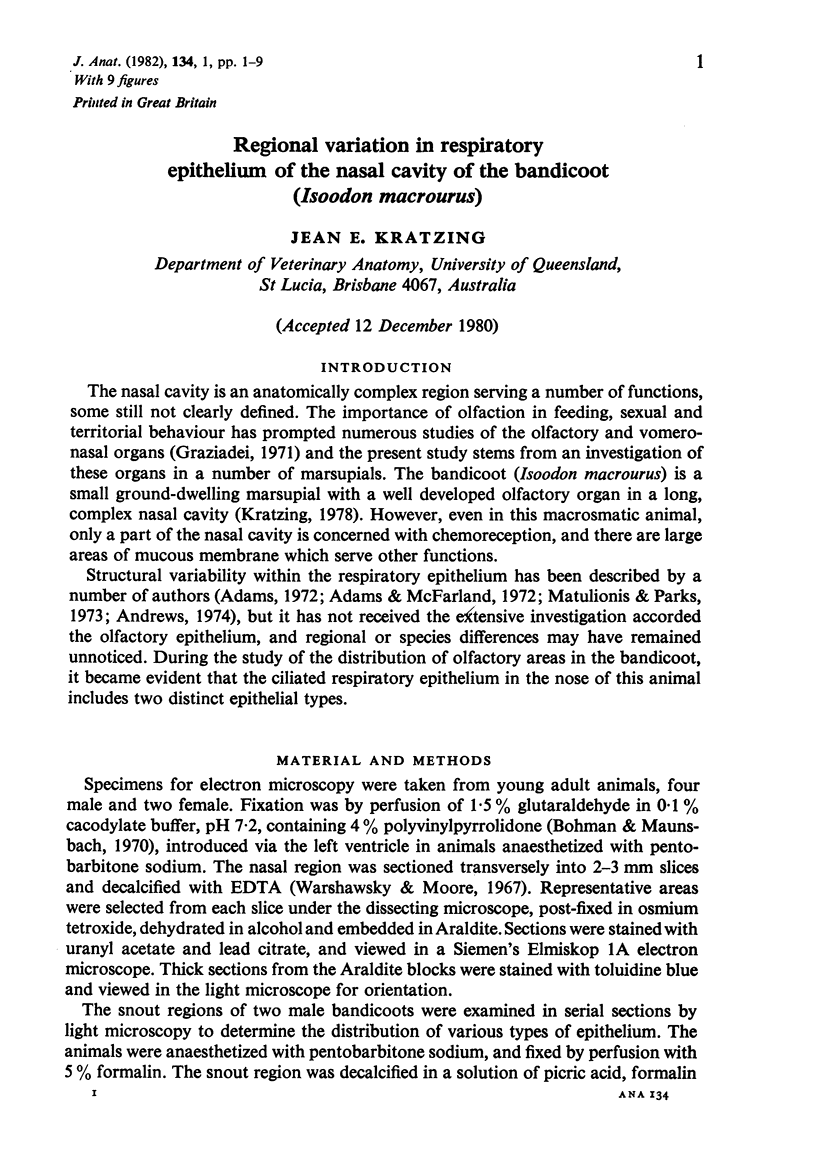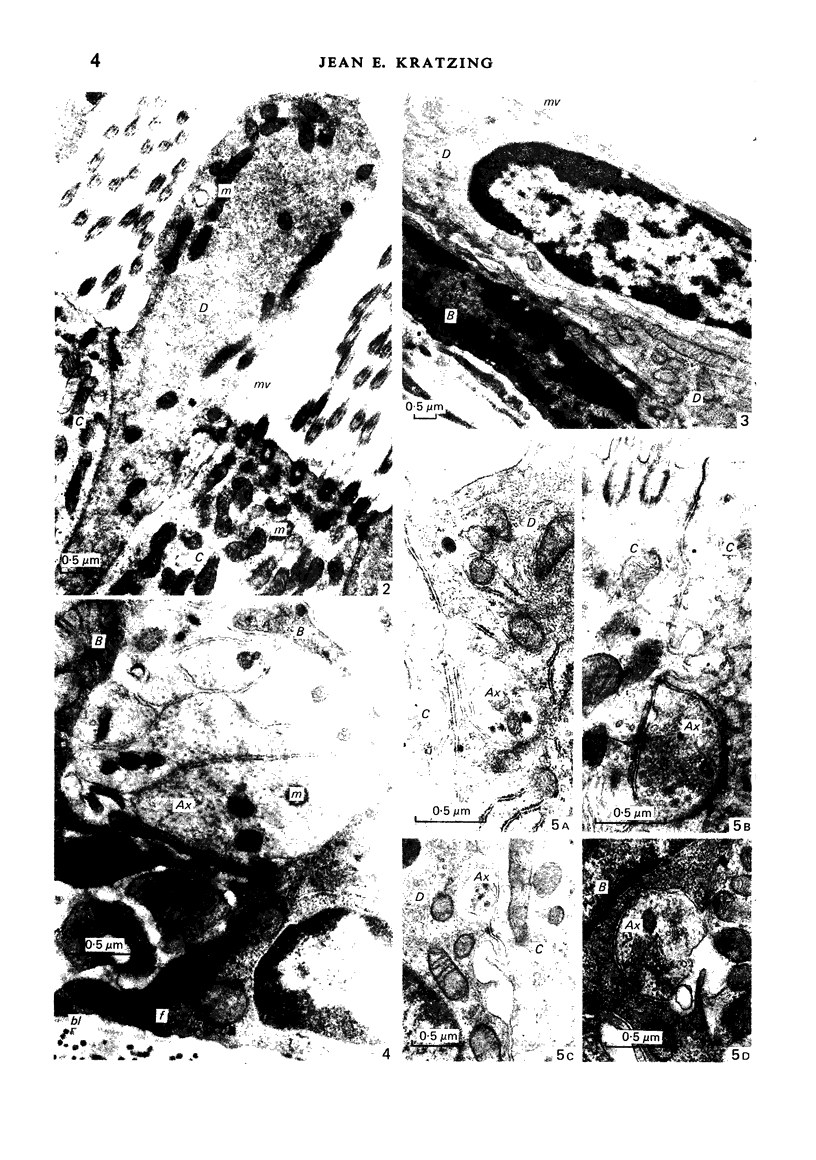Abstract
The non-olfactory ciliated epithelium of the nasal cavity was investigated in the bandicoot (Isoodon macrourus), a small ground-dwelling marsupial. Two distinct epithelial types were identified and designated conchal and septal. Conchal epithelium is non-secretory. It covers most of the naso- and maxilloturbinates, the lateral nasal wall, and part of the maxillary sinus. Septal epithelium contains mucus-secreting goblet cells. Rostrally, it covers the nasal septum and mid-ventral floor of the nasal cavity. Further caudally it lies on the ventral part of the septum and ventrally facing parts of naso- and ethmoturbinates. It corresponds closely to most published descriptions of respiratory epithelium. Ciliated and basal cells are common to both types. Conchal epithelium has a nonciliated domed cell with a rounded surface projecting into the ciliary border. This epithelium has a rich innervation and axon terminals are frequent almost to the cell surface. Septal epithelium contains goblet cells whose appearance varies according to secretory activity, and two rarer cells of unknown function, brush and pale cells, which are also seen in the olfactory epithelium of the bandicoot.
Full text
PDF








Images in this article
Selected References
These references are in PubMed. This may not be the complete list of references from this article.
- Adams D. R., McFarland L. Z. Morphology of the nasal fossae and associated structures of the hamster (Mesocricetus auratus). J Morphol. 1972 Jun;137(2):161–179. doi: 10.1002/jmor.1051370204. [DOI] [PubMed] [Google Scholar]
- Adams D. R. Olfactory and non-olfactory epithelia in the nasal cavity of the mouse, Peromyscus. Am J Anat. 1972 Jan;133(1):37–49. doi: 10.1002/aja.1001330104. [DOI] [PubMed] [Google Scholar]
- Bohman S. O., Maunsbach A. B. Effects on tissue fine structure of variations in colloid osmotic pressure of glutaraldehyde fixatives. J Ultrastruct Res. 1970 Jan;30(1):195–208. doi: 10.1016/s0022-5320(70)90073-0. [DOI] [PubMed] [Google Scholar]
- Cauna N., Hinderer K. H., Wentges R. T. Sensory receptor organs of the human nasal respiratory mucosa. Am J Anat. 1969 Feb;124(2):187–209. doi: 10.1002/aja.1001240205. [DOI] [PubMed] [Google Scholar]
- Jeffery P. K., Reid L. New observations of rat airway epithelium: a quantitative and electron microscopic study. J Anat. 1975 Nov;120(Pt 2):295–320. [PMC free article] [PubMed] [Google Scholar]
- Jeffery P., Reid L. Intra-epithelial nerves in normal rat airways: a quantitative electron microscopic study. J Anat. 1973 Jan;114(Pt 1):35–45. [PMC free article] [PubMed] [Google Scholar]
- Kratzing J. E. The fine structure of the olfactory and vomeronasal organs of a lizard (Tiliqua scincoides scincoides). Cell Tissue Res. 1975;156(2):239–252. doi: 10.1007/BF00221807. [DOI] [PubMed] [Google Scholar]
- Kratzing J. E. The olfactory apparatus of the bandicoot (Isoodon macrourus): fine structure and presence of a septal olfactory organ. J Anat. 1978 Mar;125(Pt 3):601–613. [PMC free article] [PubMed] [Google Scholar]
- Luciano L., Reale E., Ruska H. Uber eine "chemorezeptive" Sinneszelle in der Trachea der Ratte. Z Zellforsch Mikrosk Anat. 1968;85(3):350–375. [PubMed] [Google Scholar]
- Meyrick B., Reid L. The alveolar brush cell in rat lung--a third pneumonocyte. J Ultrastruct Res. 1968 Apr;23(1):71–80. doi: 10.1016/s0022-5320(68)80032-2. [DOI] [PubMed] [Google Scholar]
- Pack R. J., Al-Ugaily L. H., Morris G., Widdicombe J. G. The distribution and structure of cells in the tracheal epithelium of the mouse. Cell Tissue Res. 1980;208(1):65–84. doi: 10.1007/BF00234174. [DOI] [PubMed] [Google Scholar]
- Warshawsky H., Moore G. A technique for the fixation and decalcification of rat incisors for electron microscopy. J Histochem Cytochem. 1967 Sep;15(9):542–549. doi: 10.1177/15.9.542. [DOI] [PubMed] [Google Scholar]











